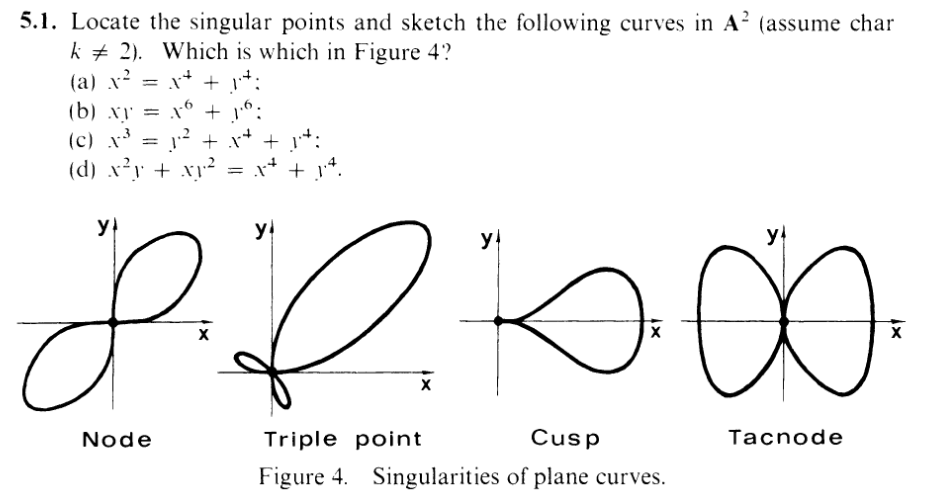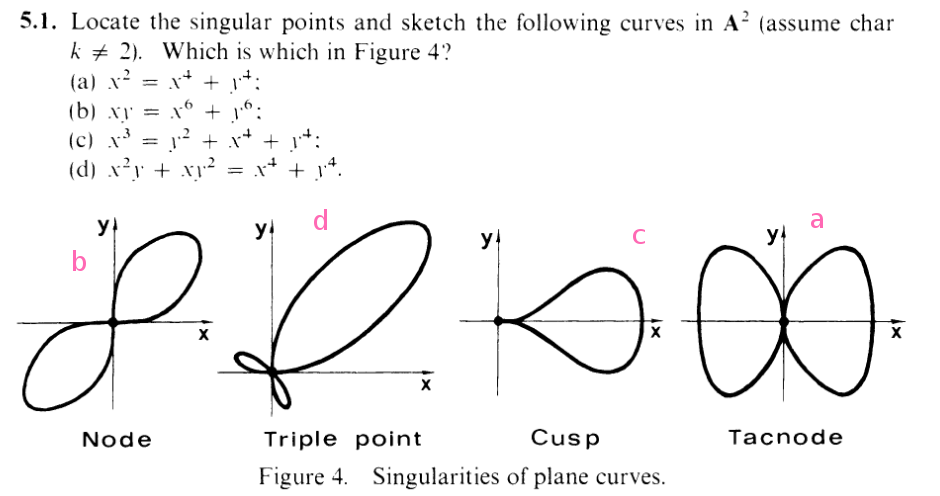I.5.1abc
6/12/2021

Hello, my loves. Welcome to a new section. Let's start by getting the
matching out of the way (just graph them on wolframalpha or something):

The rest has to do with identifying singularities! And this exercise is based on the
preliminary definition of (non)singularity:

Now, as the exercise says, each of the varieties given are curves, which means they
each have dimension 1. Hence, for each of these, a point is nonsingular iff the rank
of the Jacobian is 2 - 1 = 1. I.e. a point is singular iff the rank of the Jacobian is
0. In particular, the Jacobian in each of these examples is gonna look like
| J | =
![[ ]
∂f ∂f
-∂x ∂y-](Ip5p1abc0x.png) |
(so really, it's just the gradient vector of f) The rank of the matrix is the row span, which is just a single vector, and that is therefore 1 unless both
 and
and
 are zero. Hence, for each of these problems we are solving
are zero. Hence, for each of these problems we are solving
 | = 0 | ||
 | = 0 | ||
in addition to f = 0, so our solutions actually lie on the curve. Hence this whole exercise is basically solving systems of linear equations (over an algebraically closed field)
"Errr, can't I just look at the graphs and tell from there?" NO. Those graphs are sketches on "real" axes (i.e. non algebraically closed field). Those graphs could be missing some "imaginary"/"complex" singular points, so we do have to go through the algebra (although we do know by looking at the graphs that at least (0, 0) is a singularity for each). See part (c) as an example.
Part a
Here, f = x4 + y4 - x2. The Jacobian matrix is
| J | =
![[ ]
4x3 - 2x 4y3](Ip5p1abc5x.png) |
Hence, we need
| 4x3 - 2x | = 0 | ||
| 4y3 | = 0 |
The second equation yields y = 0. And the first equation yields x = 0 or x = ±
 . However, (0,
. However, (0,
 ) isn't a point on the curve, so the only singular
point is (0, 0)
) isn't a point on the curve, so the only singular
point is (0, 0) Part b
Here, f = x6 + y6 - xy. The Jacobian matrix is
| J | =
![[ ]
6x5 - y 6y5 - x](Ip5p1abc8x.png) |
Hence, we need
| 6x5 - y | = 0 | ||
| 6y5 - x | = 0 |
Plugging the second into the first yields
| 6(6y5)5 - y | = 0 | ||
 66y25 - y 66y25 - y | = 0 | ||
 y(66y24 - 1) y(66y24 - 1) | = 0 | ||
So y = 0 or y =

Similarly, x = 0 or x =

Plugging back each into the curve equation, clearly only (0, 0) satisfies it
Part c
Here, f = x4 + y4 + y2 - x3. So we need
| 4x3 - 3x2 | = 0 | ||
| 4y3 + 2y | = 0 |
Which factor into
| x2(4x - 3) | = 0 | ||
| 2y(y2 + 1) | = 0 | ||
 |
By "i" I mean
 , which is defined because we're in an algebraically closed
field.
, which is defined because we're in an algebraically closed
field.
Plugging in all the possibilities back into the curve equation, (0, 0) obviously
works and (
 , 0) obviously doesn't. Note that
, 0) obviously doesn't. Note that
| (-i)4 + (-i)2 | = i4 + i2 | ||
| = (i2)2 + i2 | |||
| = (-1)2 + (-1) | |||
| = 1 - 1 | |||
| = 0 |
Hence, (0,i) and (0,-i) work and (
 ,±i) doesn't. So the answers are
(0, 0), (0,±i). Note that (0,±i) are points that aren't visible on the "real"
graphs on Figure 4.
,±i) doesn't. So the answers are
(0, 0), (0,±i). Note that (0,±i) are points that aren't visible on the "real"
graphs on Figure 4. I cannot fucking figure out how to do part d. The system of equations is
| x4 + y4 - x2y - xy2 | = 0 | ||||
| 4x3 - 2xy - y2 | = 0 | ||||
| 4y3 - 2xy - x2 | = 0 | ||||
Reader: If you can solve this system of equations nicely, let me know. Otherwise, I'm skipping it.
(BTW: Some 3s and 6s showed up in this post. I was assuming that the characteristic of k wasn't 3, but if you look back you can see that the case of chark = 3 actually gets us to the answers even more quickly)